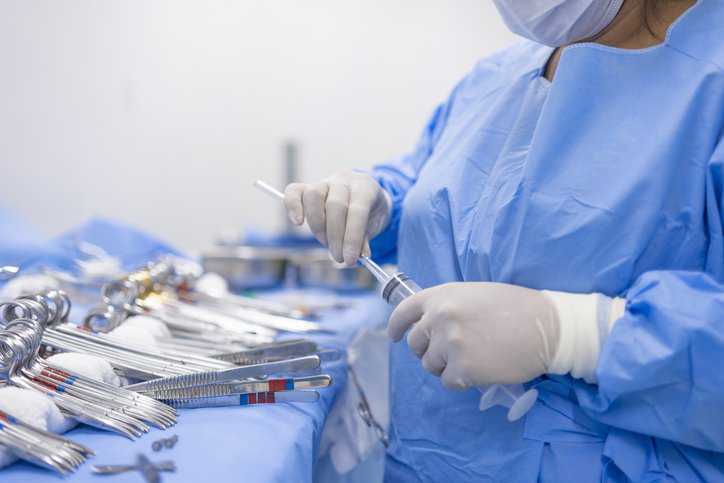ANSI/AAMI ST58:2024—Health Care Facility Sterilization

Achieving disinfection and sterilization through the use of disinfectants and sterilization practices is critical for preventing medical and surgical instruments from transmitting infectious pathogens to patients. As such, when properly used, disinfection and sterilization help assure the safe use of invasive or noninvasive medical devices. ANSI/AAMI ST58:2024— Chemical sterilization and high-level disinfection in health care facilities covers liquid chemical sterilants (LCSs)/high-level disinfectants (HLDs) and gaseous chemical sterilization system for the use in hospitals and other health care facilities.
Levels of Disinfection and Sterilization in Health Care Facilities
The method of disinfection and sterilization depends on the intended use of the medical device:
- Critical items (contact sterile body tissues or fluids) must be sterilized before use. Such items include, for example, surgical instruments, biopsy forceps, and implanted medical devices.
- Semi-critical items (contact mucous membranes or nonintact skin) must be high-level disinfected. Such items include, for example, respiratory therapy and anesthesia equipment, ultrasound probes, laryngoscope blade, and cystoscopes.
- Noncritical items (contact intact skin) should receive low-level disinfection. Such items include, for instance, bedpans, blood pressure cuffs, crutches, computers, wheelchairs, bed rails, oxygen concentrators, and pulse oximeters.
Furthermore, ANSI/AAMI ST58:2024 specifies that processes that use liquid chemical sterilization /high-level disinfection and gaseous chemical sterilization are validated by different methods. Although each method achieves acceptable microbial lethality, the standard notes some methods have limitations, and ANSI/AAMI ST58:2024 sheds lights on what to consider when using liquid chemical sterilants and high-level disinfectants.
What Is ANSI/AAMI ST58?
ANSI/AAMI ST58:2024 provides guidelines for the selection and use of liquid chemical sterilants (LCSs)/high-level disinfectants (HLDs) and gaseous chemical sterilizers that have been cleared for marketing by the U.S. Food and Drug Administration for use in hospitals and other health care facilities. Included within the scope of this American National Standard are the following:
- Functional and physical design criteria for chemical sterilization and high-level disinfection processing areas
- Staff qualifications, education, and other personnel considerations
- Criteria for selecting LCSs/HLDs and gaseous chemical sterilizers
- Safety and efficacy considerations in the use of LCSs/HLDs and gaseous chemical sterilizers
- Preparation of devices for processing by chemical sterilization or high-level disinfection; quality control methods
- Quality process improvement
What Methods do Health Care Facilities Use for Sterilization?
Sterilization in healthcare destroys all microbial life on medical devices and equipment. This process ensures the safe use of medical devices. Health care facilities use a variety of methods to sterilize items, including:
- Steam: A reliable, consistent, and lethal method recommended for heat-resistant items.
- Dry heat: Used for materials that cannot withstand moist heat or are impenetrable to it, like sharp instruments, powders, and petroleum products.
- Ethylene oxide (ETO) gas: Effectively kills microorganisms at low temperatures by disrupting their cellular process. Medical devices made from certain polymers (plastic or resin), metals, or glass, or that have multiple layers of packaging or hard-to-reach places (for example, catheters) are likely to be sterilized with ethylene oxide.
- Hydrogen peroxide gas plasma: Uses a plasma generated from hydrogen peroxide vapor to kill microorganisms on medical devices and other materials—especially those sensitive to heat.
- Vaporized hydrogen peroxide: Uses a vaporized form of hydrogen peroxide to kill microorganisms on medical devices and other materials, particularly those sensitive to high temperatures.
- Liquid chemicals: Several FDA-cleared liquid chemical sterilants are available.
- Ionizing radiation: A low-temperature sterilization method that uses cobalt 60 gamma rays or electron accelerators.
- Performic acid: A fast-acting sporicide.
- Filtration: Used to remove bacteria from thermolabile pharmaceutical fluids.
ANSI/AAMI ST58:2024— Chemical sterilization and high-level disinfection in health care facilities is available on the ANSI Webstore.






